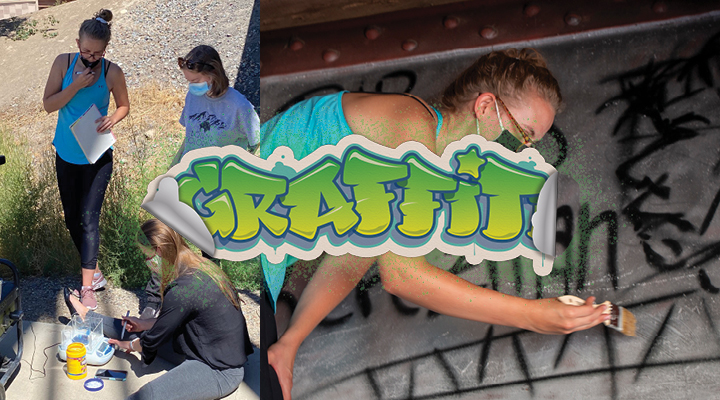Maverick Innovation Center receives patent for graffiti removal with help from numerous faculty and students
Maverick Innovation Center is home to many entrepreneurial ideas and inventions including an auto-safety device that prevents gas nozzle spills, a refillable dry-erase marker system and the Shin-Bar which reduces shin splits. One of the latest ideas to come out of the Maverick Innovation Center recently received a patent for graffiti removal.
“The Removal of Paint from Porous, Smooth, and Mineralogically Fragile Surfaces” better known as The Graffiti Removal Project, originally began in 2008 when now-retired Instructor of Chemistry Andrew Wolff, PhD, was a chief chemist at Benetech, Inc. It was there he conducted experiments with gelatinized starch, utilizing it as an adhesive to keep coal and coal dust fixated on open-top railroad boxcars. During these experiments, he noticed when the solution dried it was effective at removing paint from the cars. While he didn’t pursue the idea further at the time, he held onto it for the next 10 years until he was an instructor at CMU.
“In the spring of 2018, there was a graffiti incident on the National Monument,” said Wolff. “That annoyed me so I brushed off my previous learning and… I took the proof-of-concept to the department chair and we agreed that it would be an excellent opportunity for undergraduate research.”
As part of their undergraduate research, students Sara Clark, Ali Lange, James Peake and Yasmin Shashova, assisted Wolff in developing the ideal starch solution. These students ran trials on various solutions involving numerous starches and emulsifiers, which ultimately proved successful.
Surprisingly the removal process is fairly simple. A 3-9% starch solution is applied to the painted area, the solution is allowed to dry and later the lifted paint is brushed off with compressed air or with a power washer. Depending on the starch solution percentage and surface type, the process may be repeated with multiple coats until the paint is completely gone.
“The chemicals involved, starch and water, are, to say the least, biodegradable. So, it is an ecologically friendly composition that actually removes graffiti from rocks without damaging the rock,” said Wolff.
Throughout the years, Maverick Innovation Center Director Tom Benton has overseen a number of student- and faculty-led projects and has been instrumental in guiding this patent application to completion.
“We hope to finish an applicator in the future with the help of engineering students. Then practice applications in the Colorado National Monument or other public grounds to help them remove graffiti in an environmentally friendly way,” said Benton. “Given more success in paint removal in the ‘wild’ this project has the potential to become a licensable product for CMU or a business students can run.”
To assist with application of the solution, Assistant Professor of Mechanical Engineering Chris Penick instructed three teams of students to develop a way to transport and apply the solution to surfaces not easily accessible.
“Current, traditional methods for dealing with graffiti on rock faces in natural environment is via either mechanical removal (grinding) or chemical cover up (painting with rock colored paint). Both methods permanently ruin the rock surfaces,” said Penick. “The graffiti removal fluid is the key to breaking that cycle.”
CMU engineering students Kassidi Day, Ethan Davis, David Hale and Dylan Hallet developed the “Engineered Applicator Device for Biodegradable Starch Solution Used in Graffiti Remediation,” allowing easy application of the starch solution in off-grid locations. After a pause from COVID-19, Erik Galvan, Justin Ellsworth, Bryce Kuehl, Justin Stenman and Mahmoud Elgayar, continued their classmates prior work.
In furthering the project, current CMU student Zackary Nehm is working on applying for a second patent to protect certain aspects of the original invention.
“The second patent is to protect the range of pH values that the solution was said to work at,” said Nehm. “I ran tests to provide evidence that the solution would work at pH's ranging from 7-12.”
This patented solution and future technology applications will revolutionize keeping national parks pristine thanks in part to numerous CMU faculty and students.
